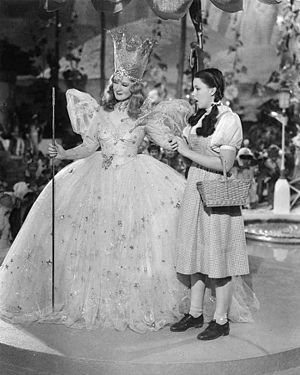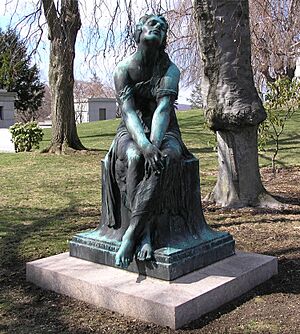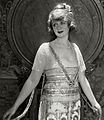Billie Burke facts for kids
Quick facts for kids
Billie Burke
|
|
|---|---|
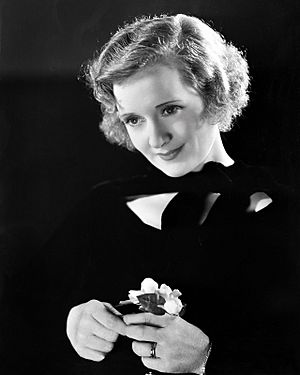
Burke in 1933
|
|
| Born |
Mary William Ethelbert Appleton Burke
August 7, 1884 Washington, D.C., U.S.
|
| Died | May 14, 1970 (aged 85) Los Angeles, California, U.S.
|
| Resting place | Kensico Cemetery |
| Occupation | Actress |
| Years active | 1903–1960 |
| Known for | Glinda the Good Witch in The Wizard of Oz |
| Spouse(s) | |
| Children | Patricia Ziegfeld Stephenson |
| Signature | |
 |
|
Billie Burke (born Mary William Ethelbert Appleton Burke; August 7, 1884 – May 14, 1970) was a famous American actress. She was well-known on Broadway (theatre in New York City), on radio, and in both silent and sound movies. Most people today remember her best as Glinda the Good Witch of the North in the classic movie The Wizard of Oz (1939).
Billie Burke was nominated for an Academy Award for Best Supporting Actress for her role in the movie Merrily We Live (1938). She was also famous for playing Mrs. Topper in the Topper film series. Her unique, high-pitched voice and elegant way of speaking often led her to play funny, sometimes silly, high-society characters.
She was married to a famous Broadway show producer, Florenz Ziegfeld Jr., from 1914 until he passed away in 1932.
Contents
Early Life and First Steps in Acting
Billie Burke was born in Washington, D.C. Her father, William "Billy" Ethelbert Burke, was a singer and clown who worked with the Barnum & Bailey Circus. Because of his job, Billie traveled a lot with her family across the United States and Europe.
Her family eventually settled in London, England. There, she loved going to plays in the West End, which is London's famous theater district. She started her own acting career on stage in London in 1903. She later returned to America to star in musical comedies on Broadway.
Becoming a Star
From 1910 to 1913, Billie Burke played lead roles in many popular Broadway shows. During this time, she met Florenz Ziegfeld, who was a very important producer. They got married in 1914, and two years later, they had a daughter named Patricia Ziegfeld Stephenson.
Billie Burke then started acting in movies, making her first film in 1915. She became incredibly successful and was one of the highest-paid actresses of her time. By 1917, she was a huge favorite among silent movie fans. She often played charming, fashionable women in comedies and dramas. Her beautiful clothes and elegant style made her a fashion icon, and many women wanted to dress like her.
After a successful period in silent films, Billie Burke returned to the stage for several years.
Hollywood Comeback and Famous Roles
In 1932, Billie Burke made a big comeback in Hollywood movies. She starred in A Bill of Divorcement, where she played the mother of Katharine Hepburn in Hepburn's very first movie. Sadly, her husband, Florenz Ziegfeld, passed away during the making of this film. But Billie bravely returned to acting soon after his funeral.
In 1933, she had a huge hit with the comedy Dinner at Eight. In this movie, she played a funny, slightly confused high-society woman. This role really boosted her career. After this, she often played similar characters: charming, but a bit ditzy, upper-class ladies with her signature high voice.
In 1937, she appeared in Topper, playing the nervous and proper Clara Topper. She was so good in the role that she came back for the movie's sequels. The next year, her performance in Merrily We Live (1938) earned her an Oscar nomination, which is a huge honor in movies.
Her most famous role came in 1939 when she played Glinda the Good Witch of the North in The Wizard of Oz. She had worked with Judy Garland (who played Dorothy) before in another movie. Billie Burke was also offered a role in the classic film Gone With the Wind, but she turned it down. Later, she starred in another successful film series, Father of the Bride (1950) and Father's Little Dividend (1951), playing the mother of Elizabeth Taylor's character.
Billie Burke also wrote two books about her life, called With a Feather on My Nose and With Powder on My Nose.
Radio and Television Appearances
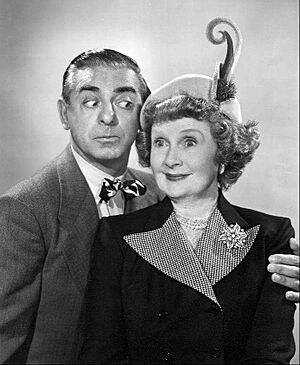
Billie Burke had her own radio show called The Billie Burke Show from 1943 to 1946. In this comedy show, she played a kind, slightly scatterbrained woman who always tried to help her neighbors.
She was also one of the first women to host her own talk show on television, called At Home With Billie Burke, which aired from 1951 to 1952. She appeared as a guest star on many other TV and radio shows too.
Later Years and Legacy
In the late 1950s, Billie Burke's memory started to fail, which made it hard for her to remember her lines. Because of this, she decided to retire from acting. She made her very last movie appearance in a western film called Sergeant Rutledge in 1960.
Billie Burke passed away in Los Angeles on May 14, 1970, at the age of 85. She is buried next to her husband, Florenz Ziegfeld.
Billie Burke's contributions to the film industry are remembered with a star on the Hollywood Walk of Fame. This is a special honor for people who have made a big impact in movies. Also, a crater (a bowl-shaped hole) near the north pole of the planet Mercury was named "Burke" after her in 2015!
Images for kids
See also
 In Spanish: Billie Burke para niños
In Spanish: Billie Burke para niños
- Academy of Music/Riviera Theatre
- List of actors with Academy Award nominations




